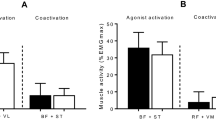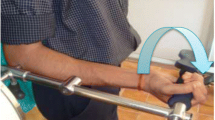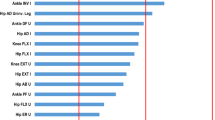Abstract
Benign joint hypermobility syndrome (BJHS) is a syndrome with musculoskeletal pain originating from the increased laxity of the joints and the ligaments. The study was to compare the isokinetic strength of knee extensor/flexor muscles of BJHS patients with healthy controls. Forty patients diagnosed as having BJHS with Brighton criteria and 45 years of age, height and weight-matched healthy controls were recruited for the study. Isokinetic testing was performed with isokinetic dynamometry of Biodex System 3Pro and measurements were recorded at knee extension/flexion pattern concentrically at 60, 180, and 240°/s angular velocities. The study group was also evaluated for functional impairment and pain by HAQ and VAS respectively. Knee extensor muscle strength was significantly lower in the patient group compared with the controls. It was hypothesized that the muscle weakness in the study group was related to lengthening of the quadriceps muscle and pain-related inactivity as well as joint instability and proprioception defect.
Similar content being viewed by others
References
Grahame R (2000) Hypermobility. Int J Clin Pract 54:314–315
Everman DB, Robin NH (1998) Hypermobility Syndrome. Pediatr Rev 19:111–117
Russek LN (1999) Hypermobility syndrome. Phys Ther 79:591–599
Silverman S, Constine L, Harvey W (1975) Survey of joint mobility and in vivo skin elasticity in London schoolchildren. Ann Rheum Dis 34:177–180
Grahame R (2003) Hypermobility and hypermobility syndrome. In: Keer R, Grahame R (eds) Hypermobility syndrome. Elsevier, London, pp 1–12
Grahame R, Brid H, Child A (2000) The revised (Brighton 1998) criteria for the diagnosis of benign joint hypermobility syndrome. J Rheumatol 27:1777–1779
Maillard S, Murray KJ (2003) Hypermobility Syndrome in Children. In: Keer R, Grahame R (eds) Hypermobility syndrome. Elsevier, London, pp 41–43
Kannus P, Beynnon B (1993) Peak torque occurrence in the range of motion during isokinetic extension and flexion of the knee. Int J Sports Med 14:422–426
Meireles SM, Oliveira LM, Andrade MS, Silva AC, Natour J (2002) Isokinetic evaluation of the knee in patients with rheumatoid arthritis. Joint Bone Spine 69:566–573
Baltzopoulos V, Brodie DA (1989) Isokinetic dynamometry. Applications and limitations. Sports Med 8:101–116
van der Esch M, Steultjens M, Knol DL, Dinant H, Dekker J (2006) Joint laxity and the relationship between muscle strength and functional ability in patients with osteoarthritis of the knee. Arthritis Rheum 55:953–959
Hsieh LF, Guu CS, Liou HJ, Kung HC (1992) Isokinetic and isometric testing of knee musculature in young female patients with patellofemoral pain syndrome. J Formos Med Assoc 91:199–205
Borman P, Celiker R, Hascelik Z (1999) Muscle performance in fibromyalgia syndrome. Rheumatol Int 19:27–30
Maqeut D, Croisier JL, Renard C, Crielaard JM (2002) Muscle performance in patients with fibromyalgia. Joint Bone Spine 69:293–299
Perrin DH (1993) Isokinetic exercise and assessment. Human Kinetics Publishers, Champaign (IL), pp 6–37
Wilk KE (1995) Isokinetic testing and exercise for the knee. In: Mangine RE (ed) Physical therapy of the knee. Churchill Livingstone, New York, pp 263–288
Baltzopoulos V (1995) Muscular and tibiofemoral joint forces during isokinetic concentric knee extension. Clin Biomech 10:208–214
Bowsher D (1998) Acute and chronic pain and assessment. In: Wells PE, Frampton V, Bowsher D (eds) Pain management and physical therapy. Appletion and Lange, Norwalk, pp 8–11
Frank JM, Moll MH, Hort JF (1982) A comparison of three ways of measuring of pain. Rheum Rehab 21:211–217
Fries JF, Spitz P, Kraines R (1980) Measurment of patient outcome in arthritis. Arthritis Rheum 23:137–145
Kucukdeveci A, Sahin H, Ataman S (2004) Issues ın cross-cultural validity: exampla from the adaptation, reliability, and validity testing of a Turkish version of the Stanford health assessment questionnaire. Arthritis Rheum 51:14–19
Hall C, Brody LT (1999) Impairment of muscle performance. In: Hall CM, Brody LT (eds) Therapeutic exercise moving toward function. Williams and Wilkins, Philadelphia, pp 59–60
Kannus P (1994) Isokinetic evaluation of muscular performance: implications for muscle testing and rehabilitation. Int J Sports Med 15:11–18
Siqueira CM, Pelegrini FR, Fontana MF, Greve JM (2002) Isokinetic dynamometry of knee flexors and extensors: comparative study among non-athletes, jumper athletes and runner athletes. Rev Hosp Clin Fac Med Sao Paulo 57:19–24
Iossifidou AN, Baltzopoulos V (2000) Peak power assessment in isokinetic dynamometry. Eur J Appl Physiol 82:158–160
Osternig LR (1986) Isokinetic dynamometry: implications for muscle testing and rehabilitation. Exerc Sport Sci Rev 14:45–80
Gross MT, McGrain P, Demilio N, Plyler L (1989) Relationship between multiple predictor variables and normal knee torque production. Phys Ther 69:54–62
Borges O (1989) Isometric and isokinetic knee extension and flexion torque in men and women aged 20–70. Scand J Rehabil Med 21:45–53
Pincivero DM, Lephart SM, Karunakara RG (1997) Relation between open and closed kinematic chain assessment of knee strength and functional performance. Clin J Sport Med 7:11–16
Jacoby SM (2001) Isokinetics in rehabilitation. In: Prentice WE, Voigth ML (eds) Techniques in musculoskeletal rehabilitation. McGraw-Hill Medical Publishing Division, New York, pp 154–160
Fossier E, Christel P, Djian P, Darman Z, Witvoet J (1993) Principles and value of isokinetic evaluation in ruptures of the anterior cruciate ligament. Rev Chir Orthop Reparatrice Appar Mot 79:615–624
Bohannon RW, Gibson DF, Larkin P (1986) Effect of resisted knee flexion on knee extension torque. Phys Ther 66:1239–1241
Aagaard P, Simonsen EB, Magnusson SP, Larsson B, Dyhre-Poulsen P (1998) A new concept for isokinetic hamstring: quadriceps muscle strength ratio. Am J Sports Med 26:231–237
Lesmes GR, Costill DL, Coyle EF, Fink WJ (1978) Muscle strength and power changes during maximal isokinetic training. Med Sci Sports 10:266–269
Soderman K, Alfredson H, Pietila T, Werner S (2001) Risk factors for leg injuries in female soccer players: a prospective investigation during one out-door season. Knee Surg Sports Traumatol Arthrosc 9:313–321
Roberts D, Ageberg E, Andersson G, Friden T (2007) Clinical measurments of proprioception, muscle strength and laxity in relation to function in the ACL-injured knee. Knee Surg Sports Traumatol Arthrosc 15:9–16
Ferrell WR, Tennant N, Sturrock RD, Ashton L, Creed G, Brydson G, Rafferty D (2004) Amelioration of symptoms by enhancement of proprioception in patients with joint hypermobility syndrome. Arthritis Rheum 50:3323–3328
Hall GM, Ferrel WR, Sturrock RD (1995) The effect of the hypermobility syndrome on knee joint proprioception. Br J Rheumatol 34:121–125
Bowerman SJ, Smith DR, Carlson M, King GA (2006) A comprasion of factors influencing ACL injury in male and female athletes and non-athletes. Phys Ther Sport 7:144–152
Wilkerson GB, Pinerola JJ, Caturano RW (1997) Invertor vs. evertor peak torque and power deficiencies associated with lateral ankle ligament injury. J Orthop Sports Phys Ther 26:78–86
Kupper JC, Loitz-Ramage B, Corr DT, Hart DA, Ronsky JL (2007) Measuring knee joint laxity: A review of applicable models and the need for new approaches to minimize variability. Clin Biomech (Bristol, Avon) 22:1–13
Shirakura K, Kato K, Udagawa E (1992) Characteristics of the isokinetic performance of patients with injured cruciate ligaments. Am J Sports Med 20:754–760
Keays SL, Bullock-Saxton JE, Newcombe P, Keays AC (2003) The relationship between knee strenght and functional stability before and after anterior cruciate ligament reconstruction. J Orthop Res 21:231–237
Goradia VK, Grana WA, Pearson SE (2006) Factors associated with decreased muscle strength after anterior cruciate ligament reconstruction with hamstring tendon grafts. Arthroscopy 22:80
Hakim A, Graham R (2003) Joint Hypermobility (review). Best Pract Res Clin Rheumatol 17:989–1004
Nijs J, Meeus M, De Meirleir K (2006) Chronic musculoskeletal pain in chronic fatigue syndrome: recent developments and therapeutic implications. Man Ther 11:187–191
Afzali L, Kuwabara F, Zachazewski J, Browne P, Robinson B (1992) A new method for the determination of the characteristic shape of an isokinetic quadriceps femoris muscle torque curve. Phys Ther 72:585–592 discussion 593–595
Scudder GN (1980) Torque curves produced at the knee during isometric and isokinetic exercise. Arch Phys Med Rehabil 61:68–73
Kellis E, Baltzopoulos V (1997) The effects of antagonist moment on the resultant knee joint moment during isokinetic testing of the knee extensors. Eur J Appl Physiol Occup Physiol 76:253–259
Grace TG, Sweetser ER, Nelson MA, Ydens LR, Skipper BJ (1984) Isokinetic muscle imbalance and knee-joint injuries. A prospective blind study. J Bone Joint Surg Am 66:734–740
Barton LM, Bird HA (1996) Improving pain by the stabilization of hyperlax joints. J Orthop Rheumatol 9:46–51
Author information
Authors and Affiliations
Corresponding author
Rights and permissions
About this article
Cite this article
Sahin, N., Baskent, A., Ugurlu, H. et al. Isokinetic evaluation of knee extensor/flexor muscle strength in patients with hypermobility syndrome. Rheumatol Int 28, 643–648 (2008). https://doi.org/10.1007/s00296-007-0493-4
Received:
Accepted:
Published:
Issue Date:
DOI: https://doi.org/10.1007/s00296-007-0493-4




